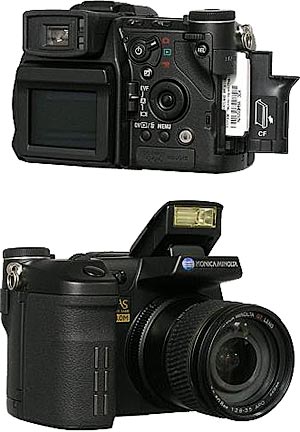Out there
Friends
Commentary
Web design
Graphics
Computers
Visual Arts
Photography
Klaus Nordby's militantly dull homepage
www.klausnordby.com/ego/minolta.html
4/6/2007
22:48
My new digital camera
Konica Minolta DiMage A2
 On Friday, June 30, 2005, I finally got my
long-awaited new digital camera, as a replacement for my semi-defunct six year old Nikon 950 (R.I.P.). After reading tons of camera reviews in the
past three months I had selected the digicam model which seemed to give me the most bang for my buck (given that I couldn't justify the steep price
of a dSLR): Konica Minolta DiMage
A2. My Boston-based cousin Hans bought it for me in the U.S. and brought it to Norway for his summer trip here (in super-pricey Norway, this
camera would have cost around twice the $500 it costs in the States).
On Friday, June 30, 2005, I finally got my
long-awaited new digital camera, as a replacement for my semi-defunct six year old Nikon 950 (R.I.P.). After reading tons of camera reviews in the
past three months I had selected the digicam model which seemed to give me the most bang for my buck (given that I couldn't justify the steep price
of a dSLR): Konica Minolta DiMage
A2. My Boston-based cousin Hans bought it for me in the U.S. and brought it to Norway for his summer trip here (in super-pricey Norway, this
camera would have cost around twice the $500 it costs in the States).
The DiMage A2 has fulfilled — and in some ways even exceeded — my expectations. It is a totally lovely camera, in its mechanical grip-feel, in the placement and usability of the numerous manual controls and in its image quality. It has 8 megapixels, a great 7x 28-200 mm (in 35mm equivalents) zoom lens and heaps of useful features — like a wonderful "Anti-Shake" image stabilizer, which can eliminate the blur-problems with hand-holding in low light situations or with large zoom ratios. After a few JPEG tests, which are also fine, I have decided to shoot nothing but raw files, as they yield the maximum quality. I use the Camera raw function in Photoshop CS2 to open and process the raw files, which are natively 36-bit, into 48-bit PSD files. These raw files are 12 Mb, so I can get 85 shots on my 1 Gb Sandisk Ultra II Compact Flash card.
Down with JPEG, up with raw!
Plain consumer digicams all save their images directly to JPEG files. This is a Very Bad Idea, quality-wise — read why here (my writings).